| International
Festival of the Sea 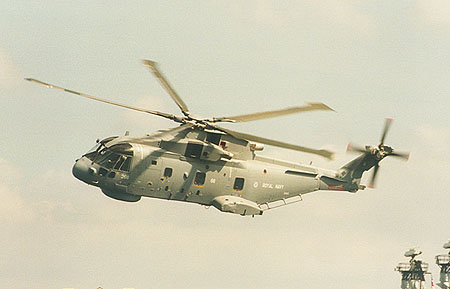 Portsmouth, 24-27 August. Portsmouth, 24-27 August.
Gary Stedman dons his sealegs.
For many years the naval dockyards at both Portsmouth and
Plymouth would open their gates to the public over a August bank holiday, their 'Navy
Days' open houses being a broadly Royal Navy equivalent to the RAF's old 'at home' shows.
Most of the RN ships in port would be open, as well as a few overseas visitors. A Sea
Harrier, along with various Fleet Air Arm Helicopters, would usually provide the aviation
interest. Our family holidays were usually taken down in Devon/Cornwall years ago and the
Plymouth 'Navy Days' were always the highlight. Once nearly cancelled because of the
Falklands War, I can still clearly remember the 1982 event. The recently returned ships
were understandably closed, many still bearing the scars of a long time spent down south.
Of course, they were the lucky ones - five others (and one merchantman) never returned.
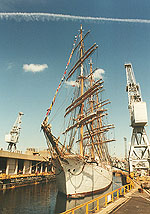 Having lived in rural East Anglia for over thirty years, just a
few miles from a now former frontline RAF fast-jet station, it was no real surprise that,
along with many others, I would develop a fascination with military aviation. Nothing
unusual there.
But, for all this time, I have managed, with varying
degrees of success, to keep a very embarrassing secret. As much as I like standing -
camera ready - on the runway 24 approach at Lakenheath on Friday mornings, I would rather
be afloat, in a small pleasure boat on the Solent, with the might of the Royal Navy
arrayed before my camera. Where the interest in the Navy came from, I have no idea, but
when the opportunity to cover this years BIG event (RIAT? you're kidding, no contest!)
came my way - I had very little hesitation in snapping it up! |
The International Festival of the Sea appears to follow
the same format as these earlier shows - it's just that everything is on a much bigger
scale. Triple the international naval representation, throw in twenty-plus tall ships,
blow up the inner basin with a tri-service showpiece, add roving bands, fireworks and a
late night concert to what you would expect to see at a airshow and you should have the
idea. Four-day festival? You need at 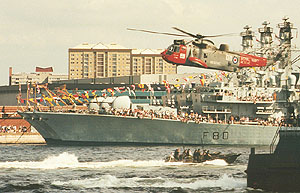 least a week! To try and do it in one day, as I did,
was going to involve some hard choices. Billed as this year's 'taking defence to the
nation' showpiece event, the 2001 Festival of the Sea was the third time the event had
been staged. With its origins at Bristol in 1996, moving to Portsmouth last time out in
1998, the event has now achieved real international status. least a week! To try and do it in one day, as I did,
was going to involve some hard choices. Billed as this year's 'taking defence to the
nation' showpiece event, the 2001 Festival of the Sea was the third time the event had
been staged. With its origins at Bristol in 1996, moving to Portsmouth last time out in
1998, the event has now achieved real international status.
As the venue is a working naval dockyard, visitors had to
be prepared for a fair walk to get round most of the exhibitions. Unlike most airshows it
is simply just not possible to head from A to B directly, as you find yourself in a maze
of inner basins and dry-docks. Frustrating when the ship, or exhibit you want to visit
appears to be so near! Thoughtfully, maps and information booths were at hand to help many
confused punters. To visit as many ships as possible, a military style plan of operation
is required, as long queues formed to board virtually all the ships very quickly. For
obvious reasons, ships' crews are only prepared to allow certain numbers of visitors to
board at any one time. A few disgruntled comments have since been heard about the queues
to board the more popular ships (HMS Illustrious and the USS Winston S. Churchill in
particular). This is nothing new, as just as long a wait could be expected whenever a RN
Nuclear fast-attack submarine was open to the public at Plymouth. To be fair, the waiting
times shown while queuing to board the Churchill were greatly exaggerated.
 When the gates (and ships) open,
the place to be, if possible, is already waiting to board HMS Illustrious, the centrepiece
of the RN display. This marked my third visit to one of the Navy's three Invincible class
CVLs, ironically all to the same one! First port of call (sorry!) is the hangar, filled
with interesting demos and stalls, but no aircraft - which are all topside. On the
flightdeck could be found at least one example, I believe, of every type (if not model) of
aircraft that has, or is likely to, operate from a Invincible class CVL. A Lynx, three
models of Sea King, Merlin, Gazelle and of course, both variants
of modern-day Harrier could all be found. Furthest forward was a true Falklands veteran,
Sea Harrier F/A2 XZ499 - it is one of the oldest surviving airframes, having started life
as a FRS1 back in 1981. Now with 801 NAS, the aircraft was credited with one Argentine A-4
when flying with 800 NAS in 1982. Walking aft are the Sea Kings, the HAS-6 and AEW-2 being
no strangers to a carrier's flightdeck, along with a troop-carrying HC-4. The Merlin has
yet to deploy operationally, 814 NAS being due to carry out the first cruise later this
year. When the gates (and ships) open,
the place to be, if possible, is already waiting to board HMS Illustrious, the centrepiece
of the RN display. This marked my third visit to one of the Navy's three Invincible class
CVLs, ironically all to the same one! First port of call (sorry!) is the hangar, filled
with interesting demos and stalls, but no aircraft - which are all topside. On the
flightdeck could be found at least one example, I believe, of every type (if not model) of
aircraft that has, or is likely to, operate from a Invincible class CVL. A Lynx, three
models of Sea King, Merlin, Gazelle and of course, both variants
of modern-day Harrier could all be found. Furthest forward was a true Falklands veteran,
Sea Harrier F/A2 XZ499 - it is one of the oldest surviving airframes, having started life
as a FRS1 back in 1981. Now with 801 NAS, the aircraft was credited with one Argentine A-4
when flying with 800 NAS in 1982. Walking aft are the Sea Kings, the HAS-6 and AEW-2 being
no strangers to a carrier's flightdeck, along with a troop-carrying HC-4. The Merlin has
yet to deploy operationally, 814 NAS being due to carry out the first cruise later this
year.
Perched on the stern were types from the RAF and AAC that
can also fly from a CVL, the 1 Squadron Harrier GR7 being flanked by a Lynx and Gazelle.
847 NAS operate the Gazelle AH1, alongside Lynx AH7s as the Royal Marine helicopter
squadron. While talking to the Lynx pilot, your dim-witted scribe made the embarrassing 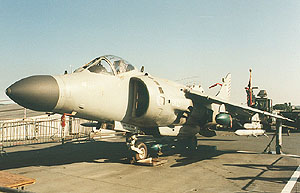 error in
assuming he was with 847 NAS, never noticing his Lynx was a wheeled
AH9 (the Marines operate skid equipped AH7s). Worse still, the AH9 is now only flown
by the Army Air Corps from a certain East Anglian airfield! Misunderstandings aside, an
informative discussion followed. A special mention must go to the superb display from the
Illustrious photography section, their beautifully atmospheric images of the ship's
aircraft in action were quite breathtaking. By the time these words are read, HMS
Illustrious will have departed for a deployment expected to last until the end of the
year, including taking part in exercise 'Saif Sareea II' in the Gulf. The ship's usual
aircraft complement will be bolstered with a detachment of RAF Harrier GR7s from 4
Squadron, the last of the RAF's three Harrier units to go to sea. error in
assuming he was with 847 NAS, never noticing his Lynx was a wheeled
AH9 (the Marines operate skid equipped AH7s). Worse still, the AH9 is now only flown
by the Army Air Corps from a certain East Anglian airfield! Misunderstandings aside, an
informative discussion followed. A special mention must go to the superb display from the
Illustrious photography section, their beautifully atmospheric images of the ship's
aircraft in action were quite breathtaking. By the time these words are read, HMS
Illustrious will have departed for a deployment expected to last until the end of the
year, including taking part in exercise 'Saif Sareea II' in the Gulf. The ship's usual
aircraft complement will be bolstered with a detachment of RAF Harrier GR7s from 4
Squadron, the last of the RAF's three Harrier units to go to sea.
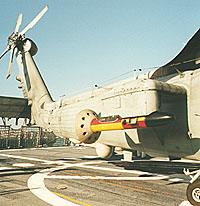 The most eagerly
anticipated visitor to the festival was the USS Winston S. Churchill, only commissioned
this year and on her first operational cruise. Although only the latest of a large number
of 'Arleigh Burke' class Anti-Air Warfare destroyers, she is only the third to be
completed to the new flight IIA standard, which deletes some of the anti-ship weaponry in
favour of a large, twin helicopter hangar. A single SH-60B Seahawk was embarked, which was
available for inspection on the flightdeck. I did make a valiant attempt to photograph the
Sea Hawk before the crowds descended upon it, but like most of the small ships
helicopters, it was badly positioned for photography. Despite some statements on the
aviation grapevine that the other USN ship present (the 'OH Perry' class "Samuel
Eliot Morison") was carrying SH-60(s), the frigate is no longer aviation capable,
only ever being able to support the now retired SH-2 Seasprite. Following the festival,
the Winston S. Churchill will be making goodwill visits to a number of UK ports, and if
you get the chance, a visit is highly recommended, as the ship's crew appear to be quite
proud of their British connection. You may even avoid a queue! The most eagerly
anticipated visitor to the festival was the USS Winston S. Churchill, only commissioned
this year and on her first operational cruise. Although only the latest of a large number
of 'Arleigh Burke' class Anti-Air Warfare destroyers, she is only the third to be
completed to the new flight IIA standard, which deletes some of the anti-ship weaponry in
favour of a large, twin helicopter hangar. A single SH-60B Seahawk was embarked, which was
available for inspection on the flightdeck. I did make a valiant attempt to photograph the
Sea Hawk before the crowds descended upon it, but like most of the small ships
helicopters, it was badly positioned for photography. Despite some statements on the
aviation grapevine that the other USN ship present (the 'OH Perry' class "Samuel
Eliot Morison") was carrying SH-60(s), the frigate is no longer aviation capable,
only ever being able to support the now retired SH-2 Seasprite. Following the festival,
the Winston S. Churchill will be making goodwill visits to a number of UK ports, and if
you get the chance, a visit is highly recommended, as the ship's crew appear to be quite
proud of their British connection. You may even avoid a queue!
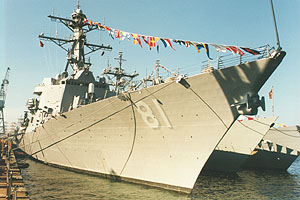 All of the Royal Navy's Type 42 Destroyers, and a
squadron of Type 23 frigates are homeported at Portsmouth. The majority were in port, and
in most cases open to the public for boarding. Most of these ships did not have Lynx (or
Merlin for the Type 23 frigate) helicopters on board. Although not normally embarked when
at Portsmouth, the Navy's problems with Lynx rotor-heads has severely limited the number
available for small ship operations. HMS Exeter did have a Lynx
HMA8 on display, surrounded by a array of equipment, including Sea Skua SSMs and
Stingray ASW torpedoes. Never likely to win a beauty competition, the Lynx HMA8 introduces
a new, nose mounted FLIR turret and moves the Seaspray surface search radar to a chin
mounted 360-degree radome. Ironically, the original 180-degree radar is still fitted. Lynx
helicopters embarked aboard overseas ships included the Aeronavale's
Mk 4 on board the Tourville class DD, De Grasse and the Portuguese
Mk 95 (named 'Izzi') embarked on the Corte Real, a modern 'Meko 200' class frigate. All of the Royal Navy's Type 42 Destroyers, and a
squadron of Type 23 frigates are homeported at Portsmouth. The majority were in port, and
in most cases open to the public for boarding. Most of these ships did not have Lynx (or
Merlin for the Type 23 frigate) helicopters on board. Although not normally embarked when
at Portsmouth, the Navy's problems with Lynx rotor-heads has severely limited the number
available for small ship operations. HMS Exeter did have a Lynx
HMA8 on display, surrounded by a array of equipment, including Sea Skua SSMs and
Stingray ASW torpedoes. Never likely to win a beauty competition, the Lynx HMA8 introduces
a new, nose mounted FLIR turret and moves the Seaspray surface search radar to a chin
mounted 360-degree radome. Ironically, the original 180-degree radar is still fitted. Lynx
helicopters embarked aboard overseas ships included the Aeronavale's
Mk 4 on board the Tourville class DD, De Grasse and the Portuguese
Mk 95 (named 'Izzi') embarked on the Corte Real, a modern 'Meko 200' class frigate.
A nice change from all the Navy types was Trinity House's
sole helicopter, a Bo-105 on board the THV Patricia. Painted in a smart red/grey scheme,
the helicopter is on long term lease from Bond Air Services and is utilised in support of
lighthouses. The new Dutch amphibian, Rotterdam surprisingly did not have any helicopters
embarked, despite a large flight deck and a rather obvious operational need. Other
helicopters present were a Spanish Navy SH-70 Sea Hawk on the Navarra (Perry class FFG), a
Lynx Mk 88 on the German Emden (Bremen class FFG) and a CH-124 Sea King on the Canadian
Halifax (Halifax class FFG).
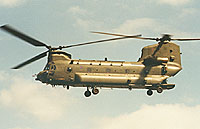 Another old favourite, the daily 'Basin Battle'
bash was staged during the sun-drenched afternoon. Although billed as a combined arms
showcase, it's really a excuse for the marines to show off! The scenario involved UK
forces rescuing a UN peace-keeping force (not for the first time!) which is soon forgotten
when the blanks start flying. With Rigid Raiders circling the inner basin, trying to soak
the main stand while waiting their cue, a Nimrod flyby, accompanied by a Tornado and Sea
Harrier opened the proceedings. The friendly held 'island' (poetic license, please!) was
quickly reinforced by abseiling marines, throwing themselves out of a 3 Regiment AAC Lynx AH9. As the bridgehead was Another old favourite, the daily 'Basin Battle'
bash was staged during the sun-drenched afternoon. Although billed as a combined arms
showcase, it's really a excuse for the marines to show off! The scenario involved UK
forces rescuing a UN peace-keeping force (not for the first time!) which is soon forgotten
when the blanks start flying. With Rigid Raiders circling the inner basin, trying to soak
the main stand while waiting their cue, a Nimrod flyby, accompanied by a Tornado and Sea
Harrier opened the proceedings. The friendly held 'island' (poetic license, please!) was
quickly reinforced by abseiling marines, throwing themselves out of a 3 Regiment AAC Lynx AH9. As the bridgehead was 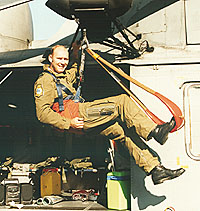 assaulted by pirate hovercraft (complete with 'Jolly Roger'), heavy
reinforcements in the form of Chinook, Merlin and Sea King helicopters arrived forcing the
circling hovercraft back. A tank landing craft (complete with embarked Warrior IFV) and
the defending Royal Marine Rigid Raiders went on the offence, assaulting the enemy held
'island' while the helicopters orbited above. With the island taken, and UN respectability
restored (for the fourth time that weekend), the final act is another RN Sea King, playing
the part of the casualty evacuation helo. Exciting stuff, and good fun to watch. assaulted by pirate hovercraft (complete with 'Jolly Roger'), heavy
reinforcements in the form of Chinook, Merlin and Sea King helicopters arrived forcing the
circling hovercraft back. A tank landing craft (complete with embarked Warrior IFV) and
the defending Royal Marine Rigid Raiders went on the offence, assaulting the enemy held
'island' while the helicopters orbited above. With the island taken, and UN respectability
restored (for the fourth time that weekend), the final act is another RN Sea King, playing
the part of the casualty evacuation helo. Exciting stuff, and good fun to watch.
 Summing up, The Festival of the Sea is a
truly enormous event, certainly on a par with RIAT - and presented in an equally
professional manner. On all the ships I was able to visit, whatever their nationality, I
found the crews both courteous and readily available to speak to the public. The team
certainly does work. Summing up, The Festival of the Sea is a
truly enormous event, certainly on a par with RIAT - and presented in an equally
professional manner. On all the ships I was able to visit, whatever their nationality, I
found the crews both courteous and readily available to speak to the public. The team
certainly does work.
|


 least a week! To try and do it in one day, as I did,
was going to involve some hard choices. Billed as this year's 'taking defence to the
nation' showpiece event, the 2001 Festival of the Sea was the third time the event had
been staged. With its origins at Bristol in 1996, moving to Portsmouth last time out in
1998, the event has now achieved real international status.
least a week! To try and do it in one day, as I did,
was going to involve some hard choices. Billed as this year's 'taking defence to the
nation' showpiece event, the 2001 Festival of the Sea was the third time the event had
been staged. With its origins at Bristol in 1996, moving to Portsmouth last time out in
1998, the event has now achieved real international status.
 error in
assuming he was with 847 NAS, never noticing his Lynx was a
error in
assuming he was with 847 NAS, never noticing his Lynx was a  The most eagerly
anticipated visitor to the festival was the USS Winston S. Churchill, only commissioned
this year and on her first operational cruise. Although only the latest of a large number
of 'Arleigh Burke' class Anti-Air Warfare destroyers, she is only the third to be
completed to the new flight IIA standard, which deletes some of the anti-ship weaponry in
favour of a large, twin helicopter hangar. A single SH-60B Seahawk was embarked, which was
available for inspection on the flightdeck. I did make a valiant attempt to photograph the
Sea Hawk before the crowds descended upon it, but like most of the small ships
helicopters, it was badly positioned for photography. Despite some statements on the
aviation grapevine that the other USN ship present (the 'OH Perry' class "Samuel
Eliot Morison") was carrying SH-60(s), the frigate is no longer aviation capable,
only ever being able to support the now retired SH-2 Seasprite. Following the festival,
the Winston S. Churchill will be making goodwill visits to a number of UK ports, and if
you get the chance, a visit is highly recommended, as the ship's crew appear to be quite
proud of their British connection. You may even avoid a queue!
The most eagerly
anticipated visitor to the festival was the USS Winston S. Churchill, only commissioned
this year and on her first operational cruise. Although only the latest of a large number
of 'Arleigh Burke' class Anti-Air Warfare destroyers, she is only the third to be
completed to the new flight IIA standard, which deletes some of the anti-ship weaponry in
favour of a large, twin helicopter hangar. A single SH-60B Seahawk was embarked, which was
available for inspection on the flightdeck. I did make a valiant attempt to photograph the
Sea Hawk before the crowds descended upon it, but like most of the small ships
helicopters, it was badly positioned for photography. Despite some statements on the
aviation grapevine that the other USN ship present (the 'OH Perry' class "Samuel
Eliot Morison") was carrying SH-60(s), the frigate is no longer aviation capable,
only ever being able to support the now retired SH-2 Seasprite. Following the festival,
the Winston S. Churchill will be making goodwill visits to a number of UK ports, and if
you get the chance, a visit is highly recommended, as the ship's crew appear to be quite
proud of their British connection. You may even avoid a queue! All of the Royal Navy's Type 42 Destroyers, and a
squadron of Type 23 frigates are homeported at Portsmouth. The majority were in port, and
in most cases open to the public for boarding. Most of these ships did not have Lynx (or
Merlin for the Type 23 frigate) helicopters on board. Although not normally embarked when
at Portsmouth, the Navy's problems with Lynx rotor-heads has severely limited the number
available for small ship operations. HMS Exeter did have a
All of the Royal Navy's Type 42 Destroyers, and a
squadron of Type 23 frigates are homeported at Portsmouth. The majority were in port, and
in most cases open to the public for boarding. Most of these ships did not have Lynx (or
Merlin for the Type 23 frigate) helicopters on board. Although not normally embarked when
at Portsmouth, the Navy's problems with Lynx rotor-heads has severely limited the number
available for small ship operations. HMS Exeter did have a  Another old favourite, the daily 'Basin Battle'
bash was staged during the sun-drenched afternoon. Although billed as a combined arms
showcase, it's really a excuse for the marines to show off! The scenario involved UK
forces rescuing a UN peace-keeping force (not for the first time!) which is soon forgotten
when the blanks start flying. With Rigid Raiders circling the inner basin, trying to soak
the main stand while waiting their cue, a Nimrod flyby, accompanied by a Tornado and Sea
Harrier opened the proceedings. The friendly held 'island' (poetic license, please!) was
quickly reinforced by abseiling marines, throwing themselves out of a 3 Regiment AAC
Another old favourite, the daily 'Basin Battle'
bash was staged during the sun-drenched afternoon. Although billed as a combined arms
showcase, it's really a excuse for the marines to show off! The scenario involved UK
forces rescuing a UN peace-keeping force (not for the first time!) which is soon forgotten
when the blanks start flying. With Rigid Raiders circling the inner basin, trying to soak
the main stand while waiting their cue, a Nimrod flyby, accompanied by a Tornado and Sea
Harrier opened the proceedings. The friendly held 'island' (poetic license, please!) was
quickly reinforced by abseiling marines, throwing themselves out of a 3 Regiment AAC  assaulted by pirate hovercraft (complete with 'Jolly Roger'), heavy
reinforcements in the form of Chinook, Merlin and Sea King helicopters arrived forcing the
circling hovercraft back. A tank landing craft (complete with embarked Warrior IFV) and
the defending Royal Marine Rigid Raiders went on the offence, assaulting the enemy held
'island' while the helicopters orbited above. With the island taken, and UN respectability
restored (for the fourth time that weekend), the final act is another RN Sea King, playing
the part of the casualty evacuation helo. Exciting stuff, and good fun to watch.
assaulted by pirate hovercraft (complete with 'Jolly Roger'), heavy
reinforcements in the form of Chinook, Merlin and Sea King helicopters arrived forcing the
circling hovercraft back. A tank landing craft (complete with embarked Warrior IFV) and
the defending Royal Marine Rigid Raiders went on the offence, assaulting the enemy held
'island' while the helicopters orbited above. With the island taken, and UN respectability
restored (for the fourth time that weekend), the final act is another RN Sea King, playing
the part of the casualty evacuation helo. Exciting stuff, and good fun to watch.